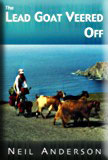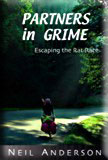|
Ring of Kerry In the morning, we coasted the remaining downhill into Kenmare. We followed N70 to Sneem getting alternately rained on for ten minutes, then sun for an equal time. Should I put on my rain jacket? Should I take off my rain jacket? It was going to be one of those days. Four-and-a-half miles before Sneem I pulled under a tree to wait for Sharon to catch up and the heavens really opened up, letting a heavy downpour rip. Sharon arrived a split second before the deluge. As we shivered under the tree, looking out at the gray mass, we decided we would look for a tea shoppe in Sneem and maybe this front would blow over. Sneem was the point the Ring of Kerry began and traffic increased steadily as we neared, although not nearly bumper to bumper as some persons had informed us the Ring became in the summer. Sneem, a past winner of an annual Tidy Towns award, looked like an ordinary tourist town. Horse carriages waited, to give tourists rides around town. Souvenir shops lined main street. A river*, cluttered with outcropping slabs of granite, effectively split Sneem in two. A short one-lane rock bridge spanned the river, connecting Sneem's two halves. The bridge was an effective bottle neck. Walking tourists crammed both sides of the narrow bridge. Cars, trucks and buses waited to thrust through on either end. We found a bakery with a tea shoppe attached. I bought jam-filled pastries and then sat next door and ordered a large pot of tea. Sharon chose a window table and watched the rain pummel our bikes on the other side of the street. Drinking sugar-laced tea we wrote postcards home--detailing the wonderful time we were having. A fellow came in and sat at the table next to us. He complained to his girlfriend, "I already changed my socks three times and only have one dry pair left." He was cycling; she was driving. He had loaded his bike into the car. Again, he lamented the injustice of wet socks. Craig was from New Jersey and had ridden the New York Five Burroughs forty-miler with twenty-five thousand cyclists and twenty-five thousand walkers. And, he smugly informed us, he had ridden the two-hundred mile Seattle spin with ten-thousand cyclists in seventeen hours. I didn't tell Craig we had once cycled farther in less time, including a two hour lunch break, with fully loaded touring bikes. No sense kicking a man when his socks are down. Craig and his girlfriend soon left, and Sharon and I were the only ones in the tea shoppe. As I waited for a hot water refill, the owner told me it was usually packed in here, cheek to jowl, at this time of year. The owner sighed, "The Americans and Germans haven't come this year like in the past. The American dollar is lower; it's keeping more of them home. The Germans are holidaying in Italy this year; the lira is so low. Ireland just doesn't have any bargains." You could say that again, I thought. A pot of hot water with a two-cent tea bag in it had just cost me five bucks. The boys we met in Tramore were right: the scenery from Sneem to Waterville was brilliant. Only a tiny rock wall separated our lane from the precipitous drop-off into the valley far below. I experienced vertigo as I ogled the terrifying view over the edge. As we rounded blind corners, we had to be aware of sudden wind gusts. The mountain road, as wide as one usual width lane had a white line sarcastically painted down its middle. Sharing the narrow road with the many tour buses was stimulating. On the Iveragh Peninsula, tour buses drove only in a counterclockwise direction. We were going clockwise. Buses took up roughly all the road, especially on corners. With an unexpected wind gust, I imagined myself plastered onto a bus's wind screen. Buses used to take outings in both directions around the Ring, but this year they had decided they would travel only one direction. As one local told us, "They could almost get by one another." Then one of them would have to back up to a wider spot so the other could nudge by. With the amount of cars lined up behind them, it was a nerve-jangling affair for everyone involved. We passed many cyclists coming towards us. Amusingly, the fella from New Jersey told us he had cycled the same direction as the buses and he was the only cyclist going in that direction. Every other cyclist he met was going the opposite direction. Well, duh. Someone could be two minutes ahead on this twisty road and never be seen. By early afternoon, we hadn't eaten anything all day, save for tea and pastry, and the sugar fix had all but fizzled out. That was the thing about quick sugar energy--it wasn't sustainable. We sheltered from the bitter wind behind a church. Rain fell intermittently and dripped off the church's roof onto my pant legs. Sharon set to work making pancakes. The corn flour I had bought looked (and squeaked), suspiciously like corn starch. It didn't combine well with the milk and duck eggs either, but it seemed to fry okay. What happened when someone ate half-a-pound of corn starch? Maybe I wouldn't crap for a week. Bonus. At the apex of the blustery pass a group of five Belgian cyclists from Brussels were drinking in the view. One chased his wind-driven ball cap toward the precipice as we approached. They were students. Three had cycled in a charity event in Morocco two years ago, and were wearing tee shirts from the sponsors. They revealed they also were free camping and had met some congenial farmers. They were the first friendly Belgians we had met. We braved the tour buses long enough to round the southwesterly tip of the peninsula and gawk at the sumptuous view provided by Sheehan's Point. Sharon felt Sheehan's Point was a must because her Grandma's maiden name was Sheehan. Grandma would be impressed by the view at this potential ancestral stomping ground. From the pass, we swooped down the chilly mountainside to Waterville and took an even smaller road, not the Ring of Kerry, out of town. Immediately the traffic vanished. Only a couple of locals passed us. All to ourselves, we encompassed a grand sweeping view of the bay.Looking for camping, we headed to Lake Cloonaghlin on a road skirting the north side of the lake. Stopping for water at a farmhouse, they assured us we would be able to find camping by the lake. We waved to a man and his wife as they worked in their garden. The road offered occasional glimpses of the lake, but fenced on both sides it allowed no access to the water. The only signs of civilization were two houses on distant hills and the sheep grazing in the field below us. Unexpectedly, the road ended--not at the pristine lake we desired--but at a large ramshackle farmhouse. Dejectedly, we turned around. In a few hundred meters, we met Timothy O'Sullivan and his young sheep dog, Sailor, walking towards us. Mr O'Sullivan was a sturdy man; a patched gray twill jacket complemented his salty windswept hair. His eyes were bright and he carried a polished wooden walking stick with a curved handle. He had seen us cruise by and knew we would be hitting the dead-end soon, so he had come scouting for us. "What'cha folks looking fo'?" he asked in his Irish brogue. "A camping spot." "I kin open one o' these gates and put'ya inta one o' my pastures," he good-naturedly responded. He led us through two gates into a velvety green mead overlooking the white caps on the lake below us. As he closed the gates, he bid us goodnight. "You're welcome t'stay as long as yas like." We swiftly set up the tent and lunged inside as a cloud torrentially burst its day-long pent-up frustration. It was midnight. |
|
|


